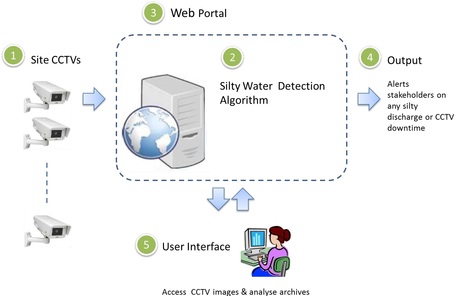Improved pollution monitoring at construction sites

Singaporean construction companies now have access to the Agency for Science, Technology and Research’s (A*STAR) Silt Imagery Detection System (SIDS), which enables them to monitor earth control measures in a manpower-efficient manner.
Earth control measures (ECM) are implemented at construction sites to safeguard Singapore’s water resources by ensuring that silt is not washed from exposed earth surfaces into the waterways after rain. Since 2013, contractors of sites of 0.5 ha and above are required to implement CCTVs at public drains to monitor treated rainwater discharges to ensure that the discharge is not silty. However, continuous monitoring of CCTV cameras is time-consuming and manpower-intensive, while periodic monitoring of CCTV images means data collected is not timely.
Singapore’s Technology Adoption Programme (TAP) enabled national water agency PUB and A*STAR’s Institute for Infocomm Research (I2R) to develop SIDS, which uses image analytics technology to detect silt discharge and CCTV downtime (ie, poor or no images). SIDS extracts and analyses real-time images from CCTVs and automatically sends alerts to various parties such as the contractor, CCTV vendor and PUB on detection of silt discharge or image problems.
“The use of image analytics through the SIDS helps the contractors to obtain real-time audits for any silty discharge into public drains and enables PUB to work closely with them to take prompt rectification action,” said Quah Hock Lai, principal engineer, PUB Catchment & Waterways department.
Increased productivity
Ho Lee Construction is a building contractor that has implemented SIDS across five construction sites since December 2015, enabling the company to save approximately 500 man-hours per year. With the automated system, workers are now redeployed to other jobs such as housekeeping work, which can include the maintenance of treatment plants, inspection and cleaning of ECM perimeter areas and drains, as well as cleaning of ECM holding tanks and mosquito vector-control work.
The SIDS also benefited Ho Lee’s CCTV vendor, Absolute Instrument Systems, which was able to reduce manual monitoring of the CCTV footages for Ho Lee. With SIDS, the vendor can automatically detect issues such as CCTV downtime or images of silty discharge and alert Ho Lee instantly.
“The biggest benefit to a contractor from [the] Silt Imagery Detection System is that it allows us to adopt a more productive and self-regulatory monitoring system for the earth control measures implemented in our project sites,” said Benjamin Tan, managing director of Ho Lee Construction. “Through self-regulation of ECM systems using this technology, as well as working with PUB and HDB, we are able to achieve our joint goal of adopting more sustainable construction practices and clean water for Singapore.”
Broader adoption
As of February 2016, PUB has enhanced its requirement for all new constructions sites with site areas of 0.2 ha and above to utilise the SIDS as part of their earth control monitoring procedures. Currently, 265 CCTV cameras at 178 construction sites island-wide are connected to the SIDS. By end-2017, 800 construction sites are expected to adopt the same technology, amounting to approximately 100,000 man-hour savings per year for construction contractors. The SIDS will also be shared with government agencies involved in development projects, as well as other major private developers to raise awareness and promote self-regulation among industry players.
Originally published here.
Specsavers partnership tackles optical waste
A nationwide recycling program is addressing the growing number of old prescription glasses and...
Concrete repair key to sustainability
This National Recycling Week, Building Chemical Supplies encourages the construction and...
Researchers to create 'affordable' jet fuel from plant waste
A research hub at The University of Queensland is taking a unique approach to converting plant...








